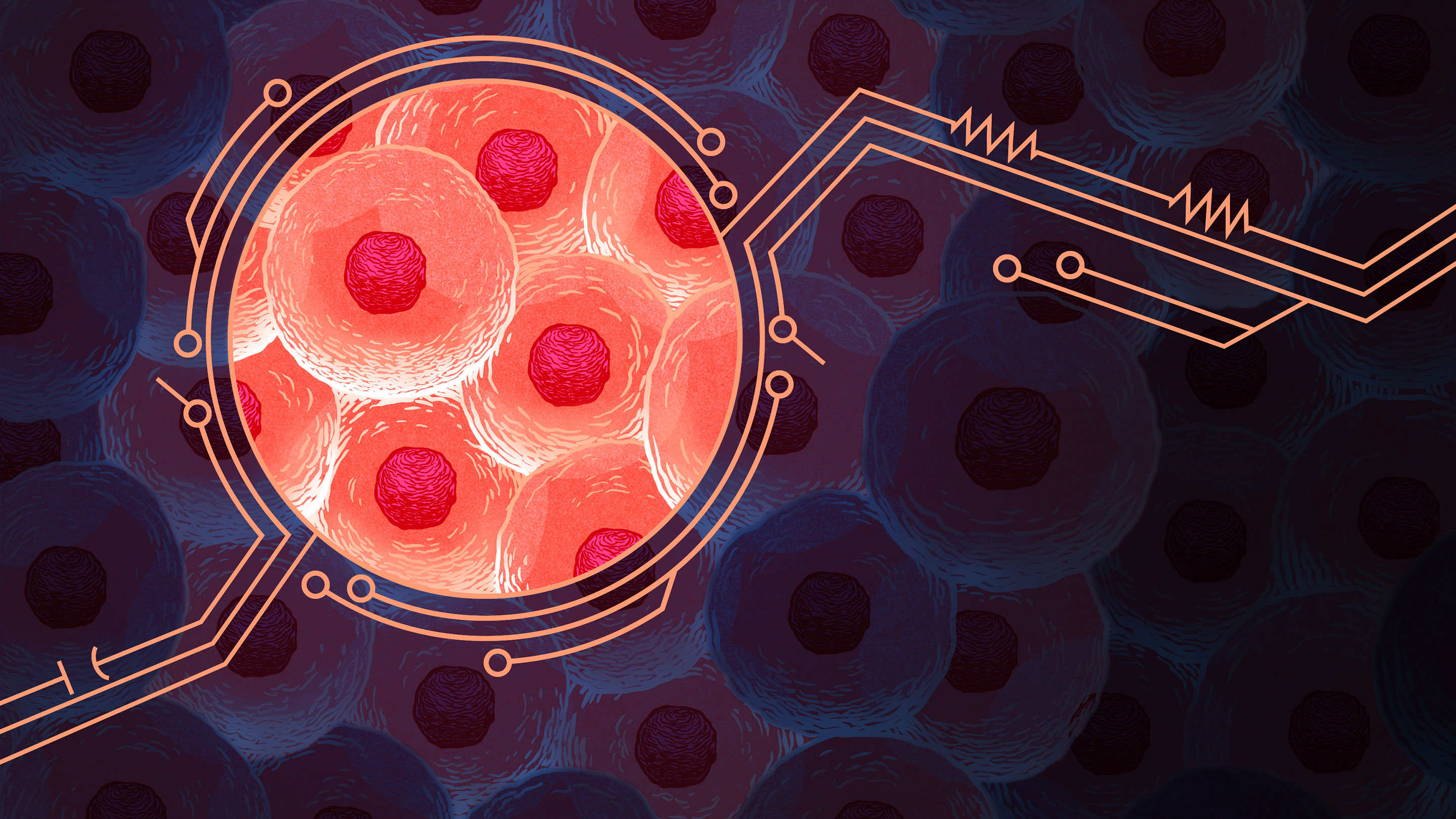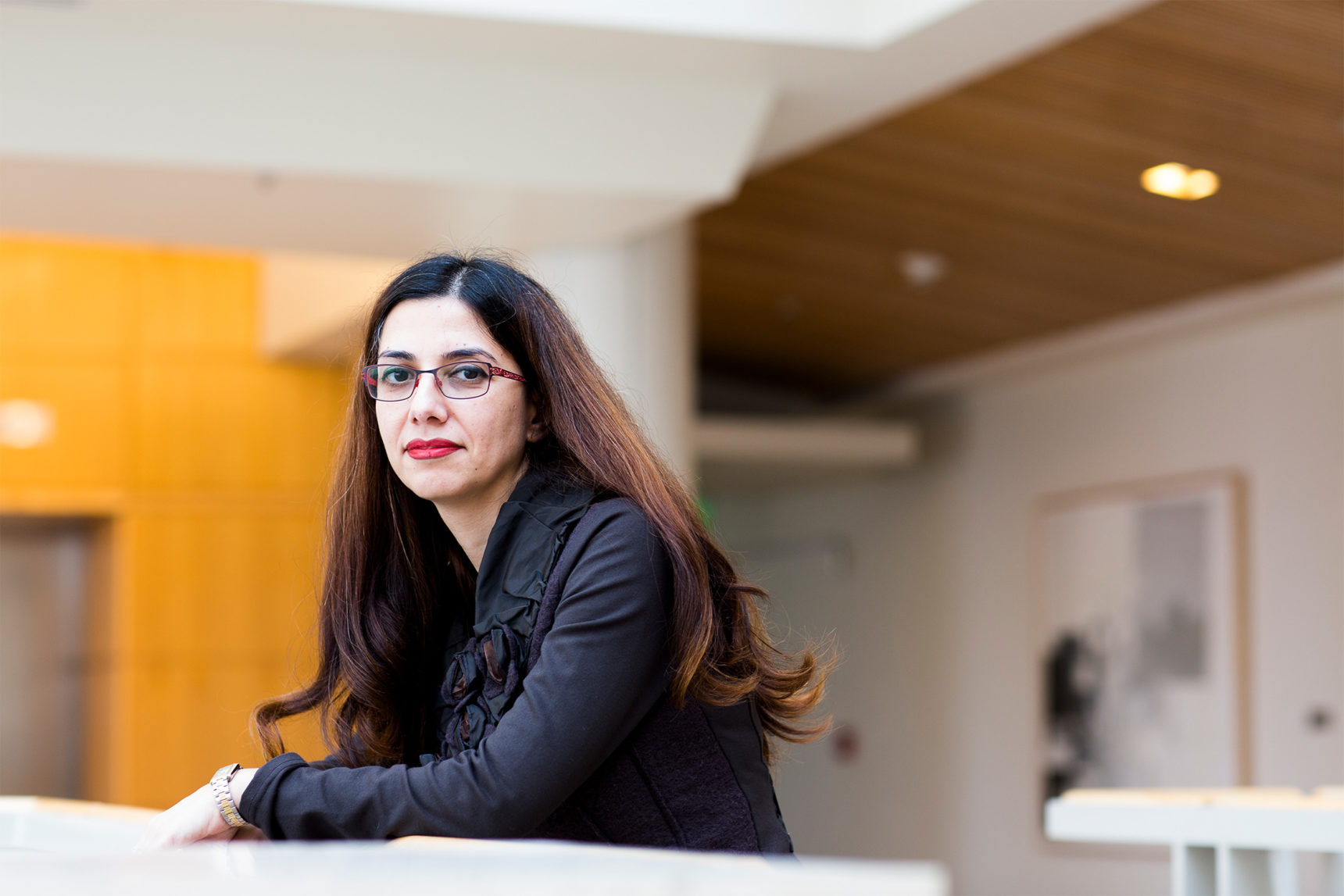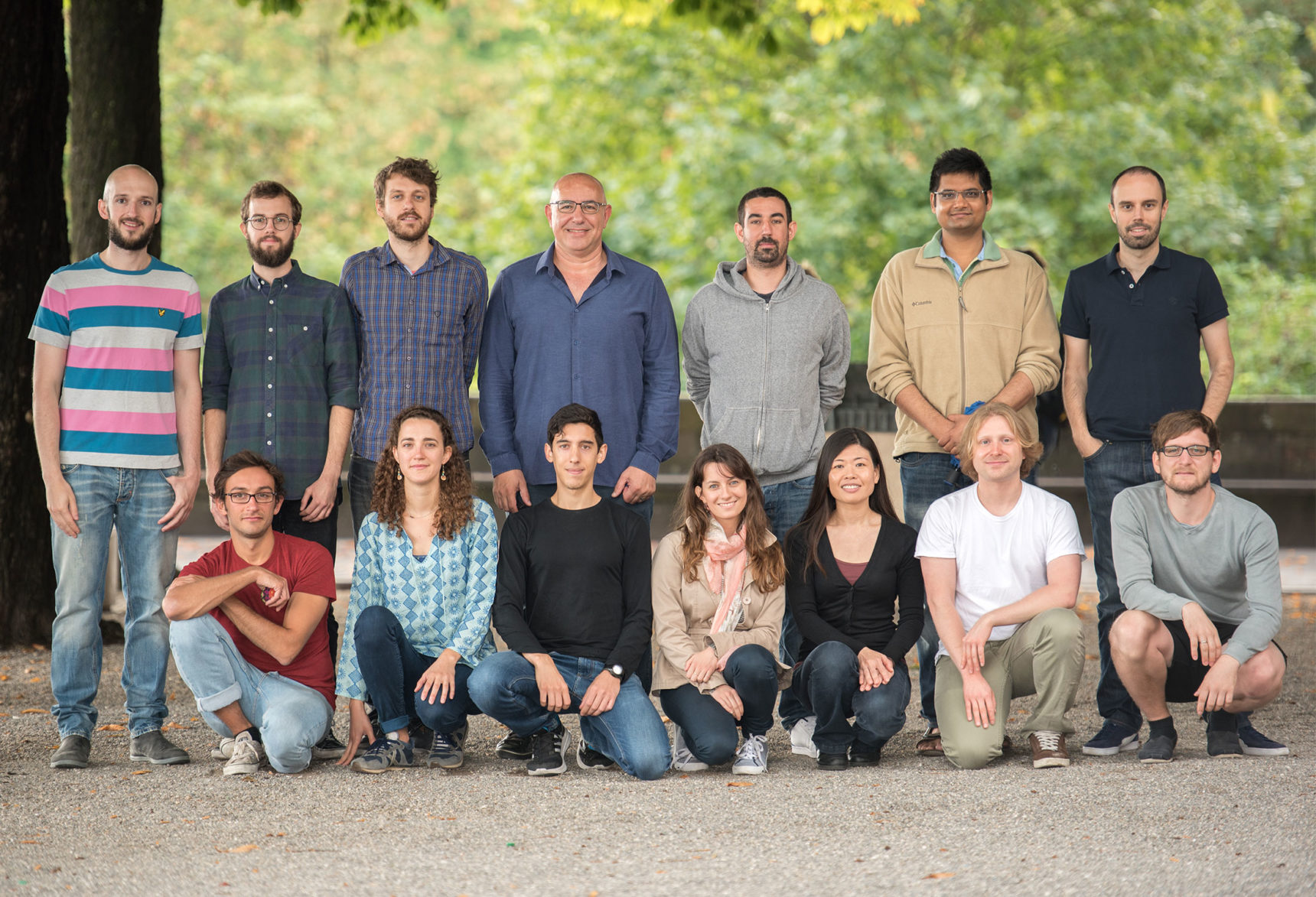Maintaining ideal stability based on negative feedback is a basic element of electrical circuits; however, it still remained a mystery how living cells manage to do this.

The small Lego robot
Mustafa Hammash is passionate about playing
peepers with a book that is held 30 cm in front of him. Hammash pushes the book forward, and the robot immediately starts buzzing with its four wheels to follow it; he moves the book closer, and the robot bounces back, remaining at a distance of 30 cm from the book. Hammash presses the car with a goggles, tilts the table at an angle, replaces the wheels with others, 30% more - and each time the robot restores the buffer zone of 30 cm between the book and starts looking at it again.
The robot’s strange ability to adjust its location gives it what biologists call sustainable ideal adaptation. “When the movement ends, no errors are observed,” said Hammash, a specialist in
management theory from the Swedish State Institute of Technology in Zurich. - This is a perfect adaptation; it perfectly maintains the distance. "
Whether it is industrial control systems, or wildlife, negative feedback (OOS) is an ubiquitous strategy that helps systems deal with disturbances. “People have noticed the existence of such feedback systems in physiology since they started to study physiology,” says Noah Olsman, a specialist in control theory from Harvard University. Homeostasis, self-regulation of biological systems, keeps many physiological parameters, for example, body temperature, pressure and blood glucose level, in a clear framework - whether we run a marathon, dive with scuba gear or arrange for ourselves to watch TV shows all day. And not in vain: “If life could not react to changes and learn, it would not last long,” said Olsman.
The robot demonstrates a steady ideal adaptation, maintaining a constant distance to the target, a moving booklet. Such behavior is impossible without negative feedback in which a controller called an “integrator” is involved
But, despite the importance of this feedback to life, it was very difficult for biologists to explain how exactly cells and more complex organisms realize OS systems with a fairly accurate and quick response. And only in the last couple of decades, scientists were able to derive some basic principles. An important breakthrough happened last summer when Hammash demonstrated an artificial OS system that can be installed on cells to help them perfectly adapt to disturbances, just like a robot does. This work is equipped with mathematical proof of the absence of a simpler way to solve this problem - and this is an indicator that natural OS systems probably work in the same way.
Long before biologists figured out how these possibilities were realized in nature, engineers learned how to create electronic circuits for control systems that allow keeping the aircraft on course, maintaining stable operation of oil refining systems and other automatic processes. Control theory experts call this fixed-point tracking with zero steady-state error. From a mathematical point of view, the OOS can correct the error in three ways: proportionally, in accordance with the absolute size of the error; integrally, by the size of the accumulated errors during operation; differentially, according to how quickly or slowly the error changes. Electronic proportional-integral-differentiating (PID)
controllers combine all three approaches and are widely used in industrial control systems.
Of all of them, it is the integrated OS that provides a stable ideal adaptation; proportional and differentiating OSs help eliminate disturbances, but do not completely correct errors. Proof of this is "an old theorem in control theory," said
John Doyle , a mathematician at the California Institute of Technology. To understand how nature achieves stable ideal adaptation, it was necessary for a specialist in control theory to notice a connection with the integral OS.
DUS is an excellent example of the striking similarities between biology and engineering. In 1948, the mathematician
Norbert Wiener proposed studying the regulatory systems of animals and machines together in the field of science, which he called
cybernetics , from the Greek “cybernetes”, “the art of control” (kybernḗtēs - steering).
“Mathematics, engineering (at least modern) and biology have one thing in common - huge hidden complexity,” Doyle said. Take, for example, a cell phone. It seems to be easy to manage, but this hides many layers of control circuits built on top of each other.
“Biology works in a similar way,” he said. - We live our lives, taking advantage of the complexity of our bodies; and if we do not get sick, they work automatically and without the participation of consciousness. We hardly notice it. ”
How to integrate cows
An electrical engineer by training, Hammash first picked up a textbook on endocrinology at Iowa State University in the fall of 1998. His wife, who had just given birth to her first child, developed
postpartum thyroiditis and wanted to know more about her illness. The text of the book “could well have belonged to a textbook on control theory, only without equations,” he said. “This hormone does that, this interaction increases the amount of that, it closes the feedback loop - the same story in a new way.”
 Mustafa Hammash, Professor of Management Theory and Systems Biology
Mustafa Hammash, Professor of Management Theory and Systems BiologyHammash became interested in this topic and went to the other end of the campus, to the National Center for Animal Diseases. There, he met physiologist Jesse Goff, who suggested that Hammash study “milk fever,” a disease of older dairy cows associated with calcium deficiency due to milk production.
Calcium ions control the work of many body functions, in particular, muscle contraction and transmission of a nerve impulse. Therefore, one of the most strictly regulated physiological variables in mammals is the level of calcium in the blood, falling in the range from 8 to 10 milligrams per deciliter. Milking depletes the calcium of cows, leading to serious violations of its blood level, says Hammash. But in a healthy cow, blood calcium levels are always restored.
“As a specialist in control systems, I immediately thought: There should be an integrator,” he said. Therefore, the question turned into the following: “How do cows integrate?”
If the car is driving too fast, or the robot has come too close to the object, the driver can take his foot off the gas pedal, and the robot can move away, directly reducing or reversing what went wrong. But in biology and chemistry, there are no subtractions - protein concentration or reaction rate cannot become negative. Even if the cell stops the production of protein, the existing molecules will not go anywhere. Instead, everything has to be controlled through the positive value of the variables — through the equivalent of the brake, which is the opposite of gas in effect. Some mathematical integration mechanisms are needed, calculating how much pressure is applied to the brake, and for how long.
To answer this question, Hammash enlisted the support of his student,
Hana El Samad , now leading his research team at the University of California, San Francisco. They quickly dismissed the possibility that the integrated controller consists of one molecule; there should have been at least two of them. When
this pair of molecules was discovered in 2002, it turned out that they were well known to physiologists: it is a
parathyroid hormone and a special form of vitamin D,
calcitriol (or 1,25-DHCC).
When calcium in the blood falls, the parathyroid gland releases more parathyroid hormone, which stimulates calcium ions to leave the skeleton, and corrects the error proportionally. An increase in the level of parathyroid hormone increases the production of calcitriol in the intestine, which enhances the absorption of calcium in the small intestine. Since the rate of calcitriol production is tied to the concentration of parathyroid hormone, the OS mechanism has an integral nature.
Hammash was not the only scientist who realized that in order to achieve a stable ideal adaptation, nature uses an integrated OS. In 2000, Doyle
mathematically showed that the effectiveness of directed movements of bacteria in search of food is achieved through the integrated OS. Later, El-Samad, Hammash and Doyle, as a result of their
joint work, showed that the shock reaction of bacteria to heat — their production of protective
chaperone molecules upon overheating — is stable for the same reason.
Installation of integrators in cells
Solving the calcium problem, in 2002 Hammash and El Samad moved to California. Hammad did not encounter a steady ideal adaptation until he moved to Zurich in 2011, and did not get the opportunity to establish a laboratory of synthetic biology. This time, his task was to artificially introduce the controller into the cells. Once such synthetic cell controllers can help patients regain control of regulatory processes that have stopped working normally, such as, for example, the production of insulin in diabetics.
By this time, synthetic biologists are already creating the simplest contours of environmental protection in cells, capable of proportionally correcting errors. The first example, the rudimentary contour in E. coli,
appeared in 2000 . After that, El-Samad
announced the introduction of a proportional OS contour with synthetic proteins developed jointly with the University of Washington. This work was important because El-Samad showed that engineered proteins can be used modularly as PnP-peripherals of computers, for example, mice or printers.
Hammash decided to learn how to program an integrated OS in cells. “Any self-respecting controller must have an integrator,” he said, especially if he wants to be stable.
However, an integrated OS is not so easy to create. “We need to do everything as correctly as possible,” said Doyle. Otherwise, the controller is destabilized. Instead of gradually approaching the target, the unstable controller will constantly miss and begin to oscillate around the target.
 Hana El-Samad, Professor of Biochemistry and Biophysics
Hana El-Samad, Professor of Biochemistry and BiophysicsHammash was joined by
Gabriel Lilacci , a theorist who had been working on a doctorate for the last year at that time, and
Stefanie Aoki , a microbiologist-postdoc. Trinity moved to the BSA-1058 building in the Rosenthal Biopark in Basel, and began to equip a new laboratory on the ground floor. None of them had experience in the field of synthetic biology.
The first circuit that Aoki and Lilacci tried was a simple circuit with a pair of controller molecules: in fact, protein A, which includes the gene for protein B, and protein B, which disables the gene for protein A.
The idea did not work. It was an unpleasant period for Aoki and Lilacci. “It doesn't work as you expect,” Aoki said. “There is a feeling that you are not in control.”
Part of the problem was that creating a cell is very difficult. Transferring well-known concepts of electrical and mechanical systems to the field of biology is a difficult task, explained Olsman. “How to take ideas that can be implemented using resistors and capacitors, and implement them using proteins, RNA and DNA?”
And even when their Escherichia coli finally began to show signs that it could correct the results of disturbances, it turned out that in fact it was an artifact of the experiment. “It must have been one of the worst days in the lab,” Lilacci said.
At that time, researchers did not understand this, but their first option was incorrect in principle. From a mathematical point of view, unicellular organisms are very different from large creatures such as cows: they are subject to statistical “noise”. Individual cells contain relatively few molecules, Hammash explained. Accident arising from the likelihood of encounters, collisions, and reactions of various molecules within a cell plays a much larger role.
Activators and anti-activators
On the eighth floor of BSA-1058, two Hammash team theorists,
Korentin Briat and
Ankit Gupta , began discussing a new idea in early 2014. They realized that in order to minimize the effect of noise, two controller molecules must have a special connection: they must connect to each other and neutralize each other's biological activity. Each should be the antithesis of the other.
In the work, Briat, Gupta and Hammash described a new scheme. In this OOS loop, the activator molecule was supposed to stimulate the production of the desired protein. The concentration of this protein, in turn, determined the production rate of the anti-activator molecule that isolated the activator. If anything disturbed the system, any error in the protein level would be corrected by a corresponding change in the rate of production of the anti-activator. And what is best, since the activator and anti-activator molecules look for and neutralize each other, such a loop will work even in a noisy cell.
Gupta mathematically proved that such a scheme would provide a stable integrator for noisy cell systems. However, all this was purely theoretical fabrications. Trinity designed it, not knowing what the opposite activator and anti-activator molecules would look like - or even that such molecules exist. Their lack of knowledge of biology became a problem when an independent expert who evaluated the article asked them for a specific example.
Hammash wrote an email to a friend, biologist
Adam Arkin from UC Berkeley, and asked for help. Arkin quickly proposed
sigma factor and anti-sigma factor proteins, abundant in bacteria. Arkin has already
used them to create an artificial switch in the cells.
However, sigma and anti-sigma were not the only possibilities. There were also semantic and
antisense RNAs , various toxins and antitoxins. “There are mountains of chemical reactions suitable for this task,” said Olsman.
 Members of the Hammash Laboratory in Zurich
Members of the Hammash Laboratory in ZurichThe theory
was published in January 2016 and caused great enthusiasm. “Now it’s completely clear how to implement this integration,” said Olsman. Two months earlier, Hammash had asked Aoki and Lilacci to postpone the development that they had been working on for three years and try to create this controller instead. “The theoretical basis for him was much more solid,” said Lilacci. They agreed to try using the same pair of sigma and anti-sigma factors that Arkin suggested.
Nothing came of them - at least at first. Aoki and Lilacci had to do something with two basic assumptions, which in reality were not fulfilled. One by one it turned out that the number of cells will not grow and dilute the factors involved in the process. However, they grew, and in the case of E. coli, the number of cells doubled every 30 minutes. According to another, it turned out that the rate of expression of proteins can be adjusted within any limits, but in fact there is a limit to it.
In the fall of 2017, while his colleagues continued their efforts in the laboratory, Gupta went to a conference in Ohio. There he met with other researchers who tried to integrate integrators into cells according to the theory of the controller with antitheses. Everyone had a problem. Gupta decided that there could be another, easier to implement scheme that would simplify the life of experimenters.
“It is wise to ask questions about the existence of simpler ways,” said Lilacci. “And it turned out that there were no such methods.”
Gupta found that the mathematical constraints for a stable ideal adaptation were so severe that they limited the options for circuits that could be stable in noisy environments. And they all needed a pair of opposing molecules.
Hammash and Gupta gleefully accepted the mathematical proof that their approach, albeit difficult, was not only reliable, but inevitable. Aoki and Lilacci, who had already seen the first signs that their cells might begin to adapt to disturbances, this news only spurred.
“Finding out that there is only one basic topology that can achieve this result was very surprising for me,” Aoki said.
Finally, Aoki and Lilacci bred a set of Escherichia coli able to maintain stable fluorescence even in the face of disturbances in the form of an introduced enzyme that consumed the green fluorescence protein. An even more interesting thing happened in another set of cells when they lowered the incubation temperature from 37 to 30 degrees Celsius, but the cell growth rate did not change. Gupta's evidence and experiments by Aoki and Lilacci
were described this June in the journal Nature.
Olsman hopes that this example will contribute to the penetration of more rational and mathematical approaches into the field of synthetic biology, will make it more engineering. “We are not building a thousand aircraft to raise them into the sky and hope that they do not fall,” he said.
In addition to stable ideal adaptation, there are many more mysterious biological phenomena that require decoding - and Doyle hopes that it will be possible to carry out it using mathematics.